Avoid losing your email account via "Proof Of Payment" phishing emails
Phishing/ScamAlso Known As: Proof Of Payment spam
Get free scan and check if your device is infected.
Remove it nowTo use full-featured product, you have to purchase a license for Combo Cleaner. Seven days free trial available. Combo Cleaner is owned and operated by RCS LT, the parent company of PCRisk.com.
What is the "Proof Of Payment" scam email?
The "Proof Of Payment email scam" refers to a spam campaign, a mass-scale operation during which deceptive emails are sent by the thousand. The messages distributed through this campaign claim to contain a payment-related document attached to them.
The fake attachment redirects to a phishing website, which is presented as an email account sign-in page. The site is designed to record log-in credentials (i.e., passwords) entered into it, thereby allowing the scammers access to the vulnerable information and the associated email account.
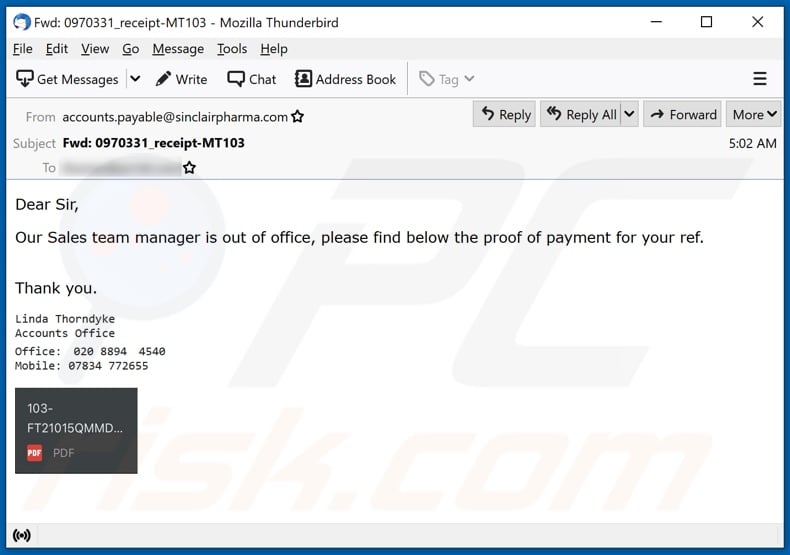
The "Proof Of Payment" scam emails (subject/title "Fwd: 0970331_receipt-MT103" may vary) contain a brief message claiming that the "Sales team manager" is currently unavailable, and thus proof of payment has been sent to the recipient.
The messages do not have a file attached to them - they contain an image of a PDF document. When this image is clicked, recipients are redirected to a website. As mentioned in the introduction, the site promoted by these emails is a phishing website and is disguised as an email account log-in page.
Any passwords entered into this site will be revealed to the scammers behind the spam campaign. Therefore, by attempting to sign-in through the web page, recipients have their email accounts stolen.
Emails are of particular interest to scammers, as they are typically connected to other accounts, platforms, services, etc. Therefore, through a hijacked email, access may be gained to associated accounts.
To elaborate on how they can be misused: communication platforms (e.g., emails, social networking/media, messengers, etc.) can assume the genuine owner's identity and ask their friends/contacts for loans.
Alternatively, through these accounts, scammers can proliferate malware by sharing infectious files/links. Finance-related platforms and services (e.g., banking, online money transferring, digital wallet, e-commerce, and similar accounts) can be used to make fraudulent transactions and online purchases.
To summarize, by trusting the "Proof Of Payment" scam messages, users can lose their email accounts and experience severe privacy issues, financial losses, and identity theft.
If attempts to sign-in through the phishing website have already been made, you are strongly advised to change the passwords of the compromised email account and the accounts connected to it. Additionally, contact the official support of all potentially exposed platforms.
| Name | Proof Of Payment Email Scam |
| Threat Type | Phishing, Scam, Social Engineering, Fraud |
| Fake Claim | Scam emails claim to contain proof of payment documents attached to them. |
| Related Domains | likeable-quintessential-mice.glitch[.]me |
| Detection Names (likeable-quintessential-mice.glitch[.]me) | CyRadar (Malicious), ESET (Phishing), Fortinet (Phishing), Full List Of Detections (VirusTotal) |
| Serving IP Address (likeable-quintessential-mice.glitch[.]me) | 52.22.118.126 |
| Symptoms | Unauthorized online purchases, changed online account passwords, identity theft, illegal access of the computer. |
| Distribution methods | Deceptive emails, rogue online pop-up ads, search engine poisoning techniques, misspelled domains. |
| Damage | Loss of sensitive private information, monetary loss, identity theft. |
| Malware Removal (Windows) |
To eliminate possible malware infections, scan your computer with legitimate antivirus software. Our security researchers recommend using Combo Cleaner. Download Combo CleanerTo use full-featured product, you have to purchase a license for Combo Cleaner. 7 days free trial available. Combo Cleaner is owned and operated by RCS LT, the parent company of PCRisk.com. |
"Password is about to expire today", "Mail Quota", and "clustered e-mails pending" are some examples of spam campaigns similar to "Proof Of Payment email scam". These large-scale operations are used for phishing, various other scams, and even malware (e.g., trojan, ransomware, etc.) proliferation.
The emails are usually presented as "important", "urgent", "priority", and so on. They may be disguised as mail from legitimate authorities, institutions, organizations, companies, service providers, and other entities.
The sole purpose of these deceptive/scam messages is to generate profit for the scammers/cyber criminals behind them. Due to the widespread nature of spam mail, exercise caution with incoming emails.
How do spam campaigns infect computers?
Systems are often infected via malicious files distributed through spam campaigns. These files can be attached and/or linked inside the emails. Infectious files can be in various formats (e.g. Microsoft Office and PDF documents, archive and executable files, JavaScript, etc.).
When these files are executed, run or otherwise opened, the infection process (i.e. malware download/installation) is triggered. For example, Microsoft Office documents (e.g. "Invoice_24077.xlsb") cause infections by executing malicious macro commands.
In Microsoft Office versions released prior to 2010, malware download/installation begins when an infectious document is opened, however, newer versions have "Protected View" mode that prevents automatic execution of macros. Instead, users are asked to enable macro commands (i.e., to enable editing/content) and hence infection processes can only be started by manually enabling macros.
How to avoid installation of malware
To avoid malware spread via spam mail, you are strongly advised against opening suspicious or irrelevant emails, especially those with any attachments or links present within them.
Additionally, use Microsoft Office versions released after 2010. Malicious programs also proliferate through untrusted download channels (e.g. unofficial and free file-hosting sites, Peer-to-Peer sharing networks and other third party downloaders), illegal software activation ("cracking") tools, and fake updaters.
Therefore, only download from official/verified sources and activate and update software with tools/functions provided by legitimate developers.
To ensure device integrity and user privacy, have a reputable anti-virus/anti-spyware suite installed and kept updated. Furthermore, use these programs to run regular system scans and to remove detected/potential threats.
If you have already opened malicious attachments, we recommend running a scan with Combo Cleaner Antivirus for Windows to automatically eliminate infiltrated malware.
Text presented in the "Proof Of Payment" scam email message:
Subject: Fwd: 0970331_receipt-MT103
Dear Sir,
Our Sales team manager is out of office, please find below the proof of payment for your ref.
Thank you.
Linda Thorndyke
Accounts Office
Office: 020 8894 4540
Mobile: 07834 772655
Screenshot of the phishing website promoted by the "Proof Of Payment" spam campaign:
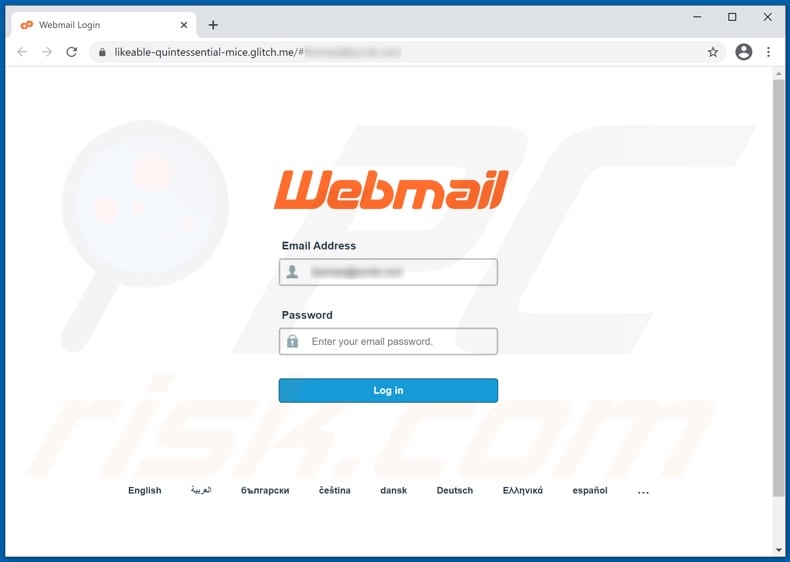
Another example of Proof of Payment-themed spam email:
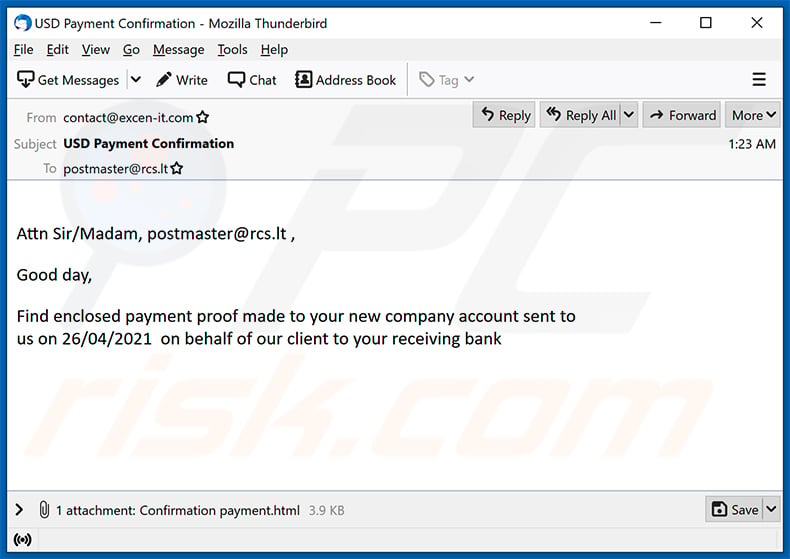
Text presented within:
Subject: USD Payment Confirmation
Attn Sir/Madam, ********,
Good day,
Find enclosed payment proof made to your new company account sent to
us on 26/04/2021 on behalf of our client to your receiving bank
Screenshot of the attached HTML document which sends all the input to cyber criminals:
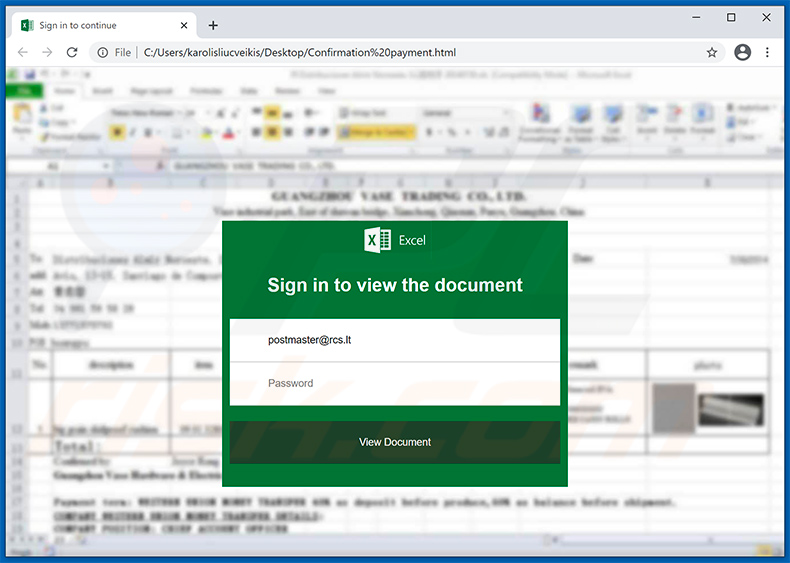
Another example of an email from "Proof Of Payment" spam campaign:
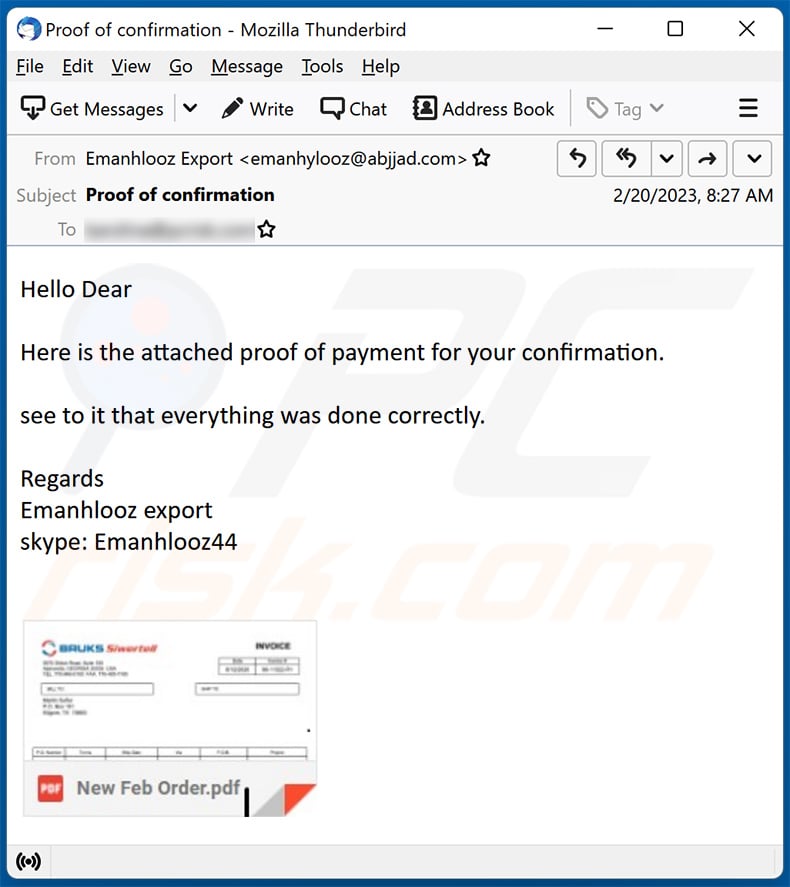
Text presented within:
Subject: Proof of confirmation
Hello Dear
Here is the attached proof of payment for your confirmation.
see to it that everything was done correctly.
Regards
Emanhlooz export
skype: Emanhlooz44
Screenshot of the promoted phishing site:
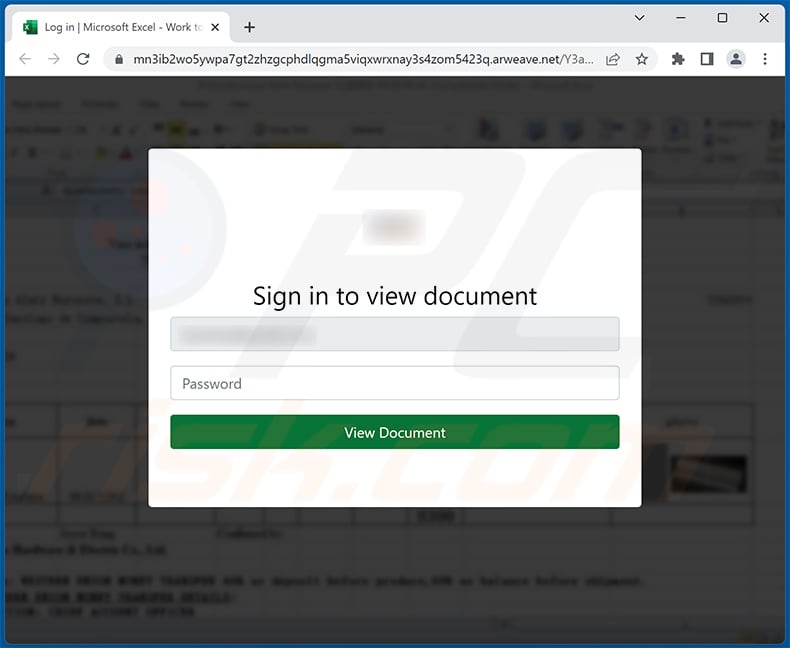
Screenshot of a Spanish email variant from "Proof Of Payment" spam campaign:
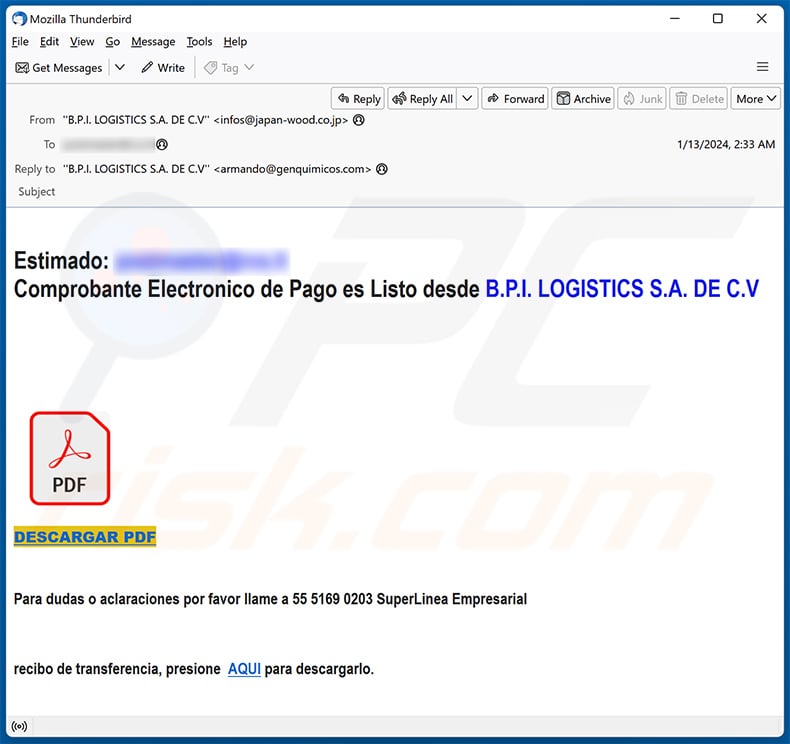
Text presented within:
Estimado:********
Comprobante Electronico de Pago es Listo desde B.P.I. LOGISTICS S.A. DE C.V
DESCARGAR PDFPara dudas o aclaraciones por favor llame a 55 5169 0203 SuperLinea Empresarial
recibo de transferencia, presione AQUI para descargarlo.
Screenshot of the promoted phishing site:
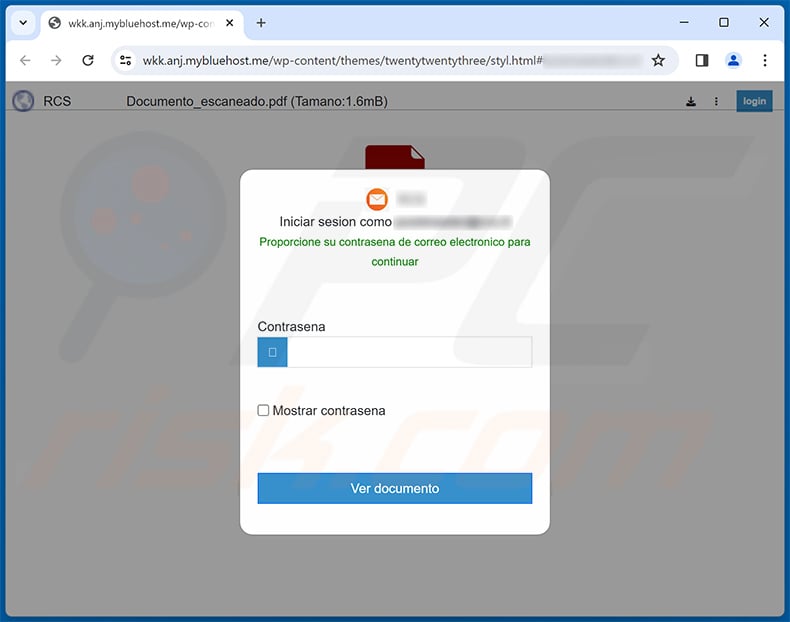
Yet another example of an email from "Proof Of Payment" spam campaign:
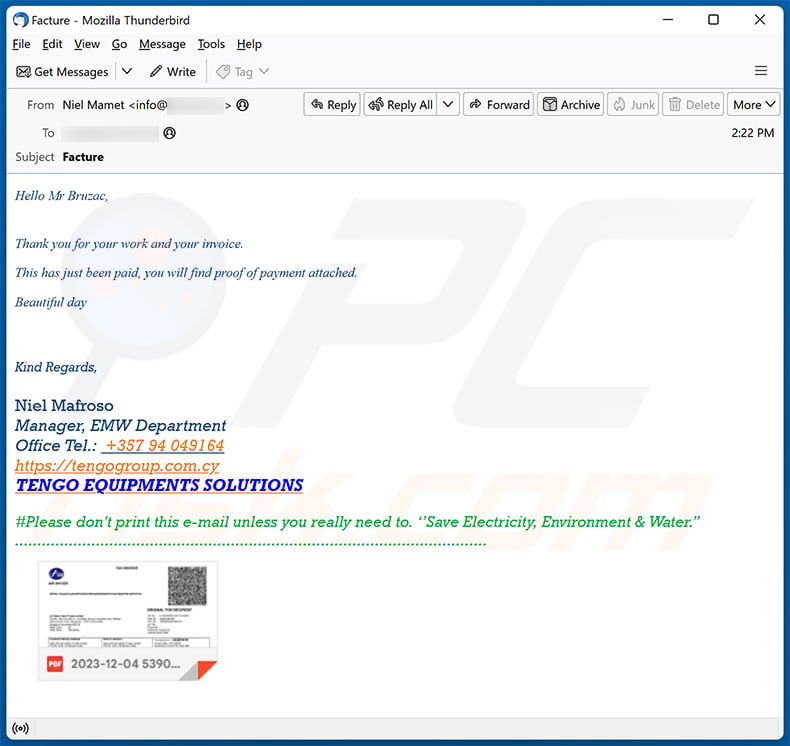
Text presented within:
Subject: Facture
Hello Mr Bruzac,
Thank you for your work and your invoice.
This has just been paid, you will find proof of payment attached.
Beautiful day
Kind Regards,Niel Mafroso
Manager, EMW Department
Office Tel.: +357 94 049164
hxxps://tengogroup.com.cy
TENGO EQUIPMENTS SOLUTIONS#Please don't print this e-mail unless you really need to. ‘’Save Electricity, Environment & Water.’’
Instant automatic malware removal:
Manual threat removal might be a lengthy and complicated process that requires advanced IT skills. Combo Cleaner is a professional automatic malware removal tool that is recommended to get rid of malware. Download it by clicking the button below:
DOWNLOAD Combo CleanerBy downloading any software listed on this website you agree to our Privacy Policy and Terms of Use. To use full-featured product, you have to purchase a license for Combo Cleaner. 7 days free trial available. Combo Cleaner is owned and operated by RCS LT, the parent company of PCRisk.com.
Quick menu:
- What is Proof Of Payment spam?
- Types of malicious emails.
- How to spot a malicious email?
- What to do if you fell for an email scam?
Types of malicious emails:
![]() Phishing Emails
Phishing Emails
Most commonly, cybercriminals use deceptive emails to trick Internet users into giving away their sensitive private information, for example, login information for various online services, email accounts, or online banking information.
Such attacks are called phishing. In a phishing attack, cybercriminals usually send an email message with some popular service logo (for example, Microsoft, DHL, Amazon, Netflix), create urgency (wrong shipping address, expired password, etc.), and place a link which they hope their potential victims will click on.
After clicking the link presented in such email message, victims are redirected to a fake website that looks identical or extremely similar to the original one. Victims are then asked to enter their password, credit card details, or some other information that gets stolen by cybercriminals.
![]() Emails with Malicious Attachments
Emails with Malicious Attachments
Another popular attack vector is email spam with malicious attachments that infect users' computers with malware. Malicious attachments usually carry trojans that are capable of stealing passwords, banking information, and other sensitive information.
In such attacks, cybercriminals' main goal is to trick their potential victims into opening an infected email attachment. To achieve this goal, email messages usually talk about recently received invoices, faxes, or voice messages.
If a potential victim falls for the lure and opens the attachment, their computers get infected, and cybercriminals can collect a lot of sensitive information.
While it's a more complicated method to steal personal information (spam filters and antivirus programs usually detect such attempts), if successful, cybercriminals can get a much wider array of data and can collect information for a long period of time.
![]() Sextortion Emails
Sextortion Emails
This is a type of phishing. In this case, users receive an email claiming that a cybercriminal could access the webcam of the potential victim and has a video recording of one's masturbation.
To get rid of the video, victims are asked to pay a ransom (usually using Bitcoin or another cryptocurrency). Nevertheless, all of these claims are false - users who receive such emails should ignore and delete them.
How to spot a malicious email?
While cyber criminals try to make their lure emails look trustworthy, here are some things that you should look for when trying to spot a phishing email:
- Check the sender's ("from") email address: Hover your mouse over the "from" address and check if it's legitimate. For example, if you received an email from Microsoft, be sure to check if the email address is @microsoft.com and not something suspicious like @m1crosoft.com, @microsfot.com, @account-security-noreply.com, etc.
- Check for generic greetings: If the greeting in the email is "Dear user", "Dear @youremail.com", "Dear valued customer", this should raise suspiciousness. Most commonly, companies call you by your name. Lack of this information could signal a phishing attempt.
- Check the links in the email: Hover your mouse over the link presented in the email, if the link that appears seems suspicious, don't click it. For example, if you received an email from Microsoft and the link in the email shows that it will go to firebasestorage.googleapis.com/v0... you shouldn't trust it. It's best not to click any links in the emails but to visit the company website that sent you the email in the first place.
- Don't blindly trust email attachments: Most commonly, legitimate companies will ask you to log in to their website and to view any documents there; if you received an email with an attachment, it's a good idea to scan it with an antivirus application. Infected email attachments are a common attack vector used by cybercriminals.
To minimise the risk of opening phishing and malicious emails we recommend using Combo Cleaner Antivirus for Windows.
Example of a spam email:

What to do if you fell for an email scam?
- If you clicked on a link in a phishing email and entered your password - be sure to change your password as soon as possible. Usually, cybercriminals collect stolen credentials and then sell them to other groups that use them for malicious purposes. If you change your password in a timely manner, there's a chance that criminals won't have enough time to do any damage.
- If you entered your credit card information - contact your bank as soon as possible and explain the situation. There's a good chance that you will need to cancel your compromised credit card and get a new one.
- If you see any signs of identity theft - you should immediately contact the Federal Trade Commission. This institution will collect information about your situation and create a personal recovery plan.
- If you opened a malicious attachment - your computer is probably infected, you should scan it with a reputable antivirus application. For this purpose, we recommend using Combo Cleaner Antivirus for Windows.
- Help other Internet users - report phishing emails to Anti-Phishing Working Group, FBI’s Internet Crime Complaint Center, National Fraud Information Center and U.S. Department of Justice.
Share:

Tomas Meskauskas
Expert security researcher, professional malware analyst
I am passionate about computer security and technology. I have an experience of over 10 years working in various companies related to computer technical issue solving and Internet security. I have been working as an author and editor for pcrisk.com since 2010. Follow me on Twitter and LinkedIn to stay informed about the latest online security threats.
PCrisk security portal is brought by a company RCS LT.
Joined forces of security researchers help educate computer users about the latest online security threats. More information about the company RCS LT.
Our malware removal guides are free. However, if you want to support us you can send us a donation.
DonatePCrisk security portal is brought by a company RCS LT.
Joined forces of security researchers help educate computer users about the latest online security threats. More information about the company RCS LT.
Our malware removal guides are free. However, if you want to support us you can send us a donation.
Donate
▼ Show Discussion